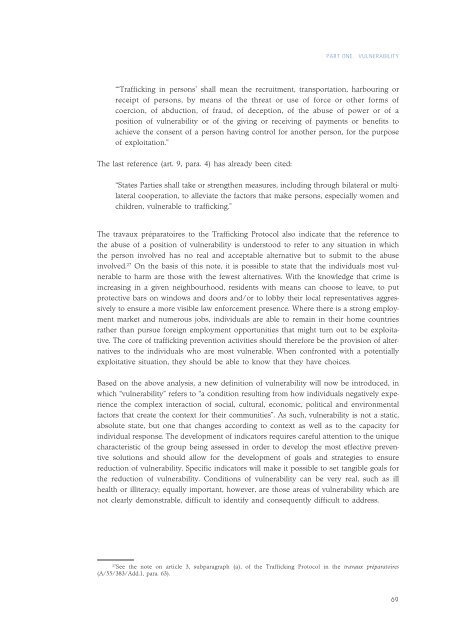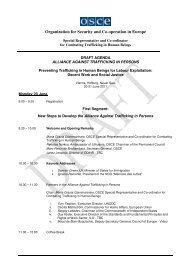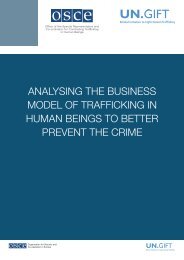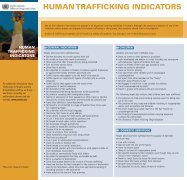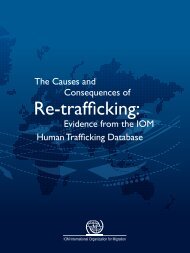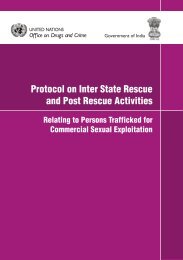An Introduction to Human Trafficking - United Nations Office on ...
An Introduction to Human Trafficking - United Nations Office on ...
An Introduction to Human Trafficking - United Nations Office on ...
You also want an ePaper? Increase the reach of your titles
YUMPU automatically turns print PDFs into web optimized ePapers that Google loves.
PART ONE.—VULNERABILITY<br />
“‘<str<strong>on</strong>g>Trafficking</str<strong>on</strong>g> in pers<strong>on</strong>s’ shall mean the recruitment, transportati<strong>on</strong>, harbouring or<br />
receipt of pers<strong>on</strong>s, by means of the threat or use of force or other forms of<br />
coerci<strong>on</strong>, of abducti<strong>on</strong>, of fraud, of decepti<strong>on</strong>, of the abuse of power or of a<br />
positi<strong>on</strong> of vulnerability or of the giving or receiving of payments or benefits <str<strong>on</strong>g>to</str<strong>on</strong>g><br />
achieve the c<strong>on</strong>sent of a pers<strong>on</strong> having c<strong>on</strong>trol for another pers<strong>on</strong>, for the purpose<br />
of exploitati<strong>on</strong>.”<br />
The last reference (art. 9, para. 4) has already been cited:<br />
“States Parties shall take or strengthen measures, including through bilateral or multilateral<br />
cooperati<strong>on</strong>, <str<strong>on</strong>g>to</str<strong>on</strong>g> alleviate the fac<str<strong>on</strong>g>to</str<strong>on</strong>g>rs that make pers<strong>on</strong>s, especially women and<br />
children, vulnerable <str<strong>on</strong>g>to</str<strong>on</strong>g> trafficking.”<br />
The travaux prépara<str<strong>on</strong>g>to</str<strong>on</strong>g>ires <str<strong>on</strong>g>to</str<strong>on</strong>g> the <str<strong>on</strong>g>Trafficking</str<strong>on</strong>g> Pro<str<strong>on</strong>g>to</str<strong>on</strong>g>col also indicate that the reference <str<strong>on</strong>g>to</str<strong>on</strong>g><br />
the abuse of a positi<strong>on</strong> of vulnerability is unders<str<strong>on</strong>g>to</str<strong>on</strong>g>od <str<strong>on</strong>g>to</str<strong>on</strong>g> refer <str<strong>on</strong>g>to</str<strong>on</strong>g> any situati<strong>on</strong> in which<br />
the pers<strong>on</strong> involved has no real and acceptable alternative but <str<strong>on</strong>g>to</str<strong>on</strong>g> submit <str<strong>on</strong>g>to</str<strong>on</strong>g> the abuse<br />
involved. 27 On the basis of this note, it is possible <str<strong>on</strong>g>to</str<strong>on</strong>g> state that the individuals most vulnerable<br />
<str<strong>on</strong>g>to</str<strong>on</strong>g> harm are those with the fewest alternatives. With the knowledge that crime is<br />
increasing in a given neighbourhood, residents with means can choose <str<strong>on</strong>g>to</str<strong>on</strong>g> leave, <str<strong>on</strong>g>to</str<strong>on</strong>g> put<br />
protective bars <strong>on</strong> windows and doors and/or <str<strong>on</strong>g>to</str<strong>on</strong>g> lobby their local representatives aggressively<br />
<str<strong>on</strong>g>to</str<strong>on</strong>g> ensure a more visible law enforcement presence. Where there is a str<strong>on</strong>g employment<br />
market and numerous jobs, individuals are able <str<strong>on</strong>g>to</str<strong>on</strong>g> remain in their home countries<br />
rather than pursue foreign employment opportunities that might turn out <str<strong>on</strong>g>to</str<strong>on</strong>g> be exploitative.<br />
The core of trafficking preventi<strong>on</strong> activities should therefore be the provisi<strong>on</strong> of alternatives<br />
<str<strong>on</strong>g>to</str<strong>on</strong>g> the individuals who are most vulnerable. When c<strong>on</strong>fr<strong>on</strong>ted with a potentially<br />
exploitative situati<strong>on</strong>, they should be able <str<strong>on</strong>g>to</str<strong>on</strong>g> know that they have choices.<br />
Based <strong>on</strong> the above analysis, a new definiti<strong>on</strong> of vulnerability will now be introduced, in<br />
which “vulnerability” refers <str<strong>on</strong>g>to</str<strong>on</strong>g> “a c<strong>on</strong>diti<strong>on</strong> resulting from how individuals negatively experience<br />
the complex interacti<strong>on</strong> of social, cultural, ec<strong>on</strong>omic, political and envir<strong>on</strong>mental<br />
fac<str<strong>on</strong>g>to</str<strong>on</strong>g>rs that create the c<strong>on</strong>text for their communities”. As such, vulnerability is not a static,<br />
absolute state, but <strong>on</strong>e that changes according <str<strong>on</strong>g>to</str<strong>on</strong>g> c<strong>on</strong>text as well as <str<strong>on</strong>g>to</str<strong>on</strong>g> the capacity for<br />
individual resp<strong>on</strong>se. The development of indica<str<strong>on</strong>g>to</str<strong>on</strong>g>rs requires careful attenti<strong>on</strong> <str<strong>on</strong>g>to</str<strong>on</strong>g> the unique<br />
characteristic of the group being assessed in order <str<strong>on</strong>g>to</str<strong>on</strong>g> develop the most effective preventive<br />
soluti<strong>on</strong>s and should allow for the development of goals and strategies <str<strong>on</strong>g>to</str<strong>on</strong>g> ensure<br />
reducti<strong>on</strong> of vulnerability. Specific indica<str<strong>on</strong>g>to</str<strong>on</strong>g>rs will make it possible <str<strong>on</strong>g>to</str<strong>on</strong>g> set tangible goals for<br />
the reducti<strong>on</strong> of vulnerability. C<strong>on</strong>diti<strong>on</strong>s of vulnerability can be very real, such as ill<br />
health or illiteracy; equally important, however, are those areas of vulnerability which are<br />
not clearly dem<strong>on</strong>strable, difficult <str<strong>on</strong>g>to</str<strong>on</strong>g> identify and c<strong>on</strong>sequently difficult <str<strong>on</strong>g>to</str<strong>on</strong>g> address.<br />
27<br />
See the note <strong>on</strong> article 3, subparagraph (a), of the <str<strong>on</strong>g>Trafficking</str<strong>on</strong>g> Pro<str<strong>on</strong>g>to</str<strong>on</strong>g>col in the travaux prépara<str<strong>on</strong>g>to</str<strong>on</strong>g>ires<br />
(A/55/383/Add.1, para. 63).<br />
69


